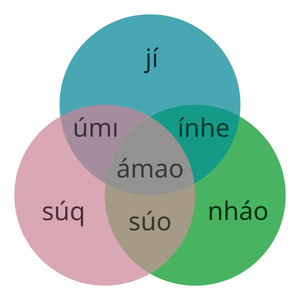Toaq has relatively many pronouns. It makes distinctions that English does not:
- Clusivity: there are many words for “we” depending on who exactly is included.
- Exophora vs. anaphora: there are different pronouns for “things or people external to the text” (exophora) vs. “references to earlier phrases” (anaphora).
- Animacy: there are different third-person pronouns for animals vs. objects vs. ideas. There are even 9 different anaphoric pronouns for different types of grammatical constructs.
| Pronoun | Meaning |
|---|---|
| jí | I, me |
| súq | you |
| nháo | he, she, they |
| kóu* | it (inanimate object) |
| róeq*, ráy* | it (abstract) |
| súo | y'all (you and they) |
| úmı*, múy | we (you and I) |
| ínhe*, míy | we (they and I) |
| ámao*, máy | we (you, they, and I) |
| há | one (people in general) |
| Pronoun | Meaning |
|---|---|
| hó | he/she/they (latest grammatically animate DP) |
| máq | it (latest grammatically inanimate DP) |
| hóq | it (latest grammatically abstract DP) |
| tá | it (latest adjective-like DP) |
| róu | it (latest |
| kóeq*, kúy | it (latest lu DP) |
| zé | it (latest object incorporating verb DP) |
| fúeq*, fúy | he/she/they/it (same referent as latest pronoun) |
| bóu | it (latest demonstrative noun phrase) |
| áq | itself/himself/herself/themselves (clause subject) |
| chéq | each other (reciprocal with clause subject) |
(* Unofficial but popular. If two forms are listed, prefer the first one since it no longer uses ay uy ıy oy ey syllables, which are now outdated.)
Notes
- All living animals have the pronoun nháo in Toaq, not just humans.
- The subject (first argument) of a clause binds only the anaphoric pronoun áq, so you cannot use hó, máq, hóq… to refer to it.
- For each pronoun, there's a verb crated by affixing -bo to it that means “___ is (that pronoun)'s”.
- For example, suqbo means “yours” and tabo means “its” (belonging to the referent of tá).
